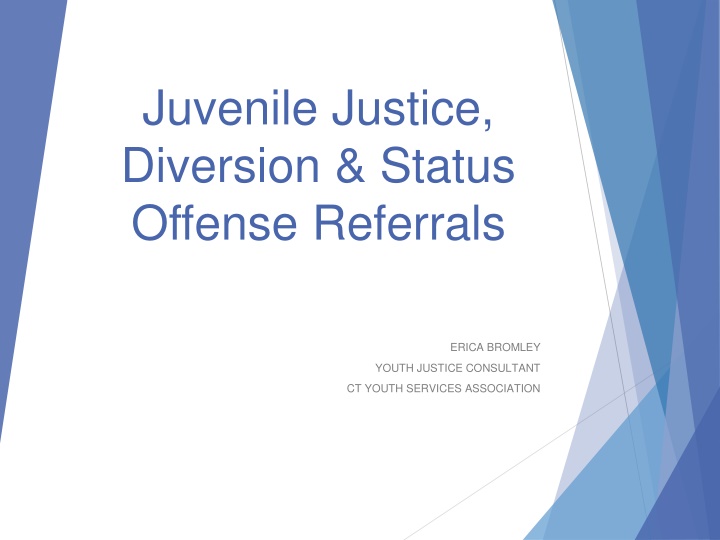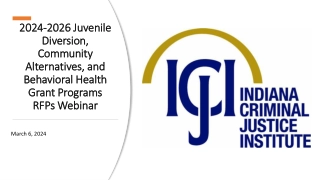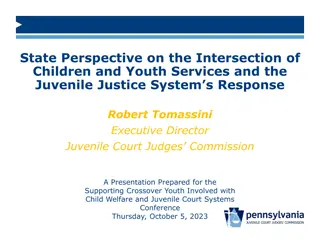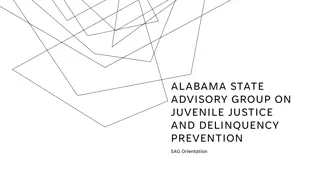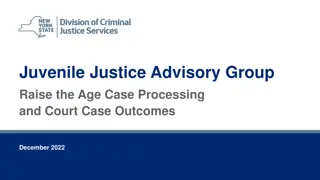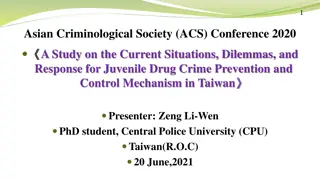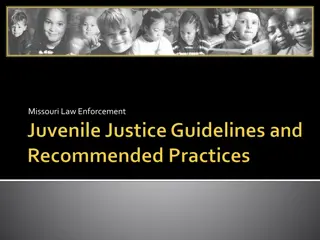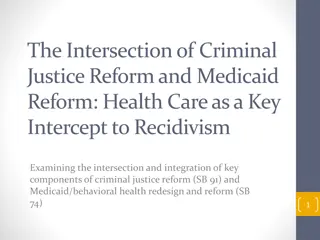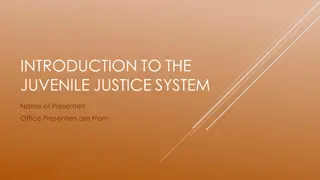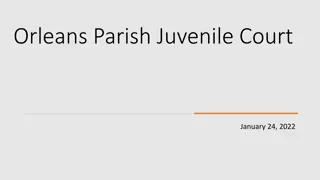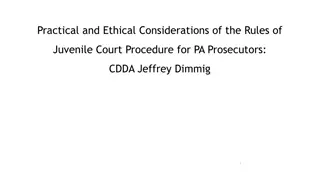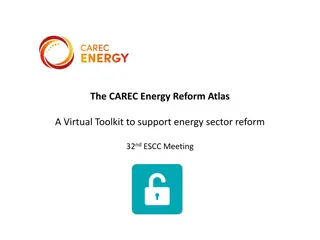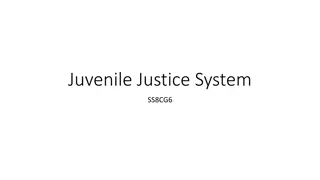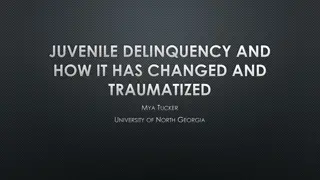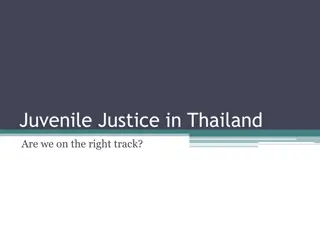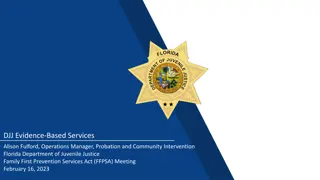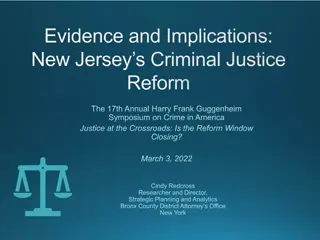Juvenile Justice Reform Efforts in Connecticut
Research highlights the detrimental impact of youth involvement in the justice system, motivating reform efforts to divert youth from system involvement and improve outcomes. Recent policy changes in Connecticut address status offenses and aim to create a better system for at-risk youth, focusing on diversion strategies, raising the age of juvenile jurisdiction, and refining case handling processes.
Download Presentation

Please find below an Image/Link to download the presentation.
The content on the website is provided AS IS for your information and personal use only. It may not be sold, licensed, or shared on other websites without obtaining consent from the author.If you encounter any issues during the download, it is possible that the publisher has removed the file from their server.
You are allowed to download the files provided on this website for personal or commercial use, subject to the condition that they are used lawfully. All files are the property of their respective owners.
The content on the website is provided AS IS for your information and personal use only. It may not be sold, licensed, or shared on other websites without obtaining consent from the author.
E N D
Presentation Transcript
Juvenile Justice, Diversion & Status Offense Referrals ERICA BROMLEY YOUTH JUSTICE CONSULTANT CT YOUTH SERVICES ASSOCIATION
Juvenile Justice Reform Juvenile Justice and Diversion Research shows that any involvement with the justice system is detrimental to a young person and increases the likelihood that they will re-enter the system at a later date System involvement can be at the police level and up through court and beyond Goal is ultimately to divert youth from any kind of system involvement (even with another agency like DCF) Reform efforts occur at the JJPOC (discussed later) and the legislature, as well as through a variety of advocacy organizations to improve diversion and the system itself Want to create a system to keep kids from ever entering the system in the first place, but if they need to enter, creating the best process and conditions for the most optimal outcomes
Juvenile Justice and Diversion in Connecticut Law/Policy changes over the last 5-10 years Status Offenses Truancy/Defiance of School Rules 2017/18 Other Status Offenses (Runaway, Beyond Control, Indecent/Immoral Conduct) - 2020 Raise the Age age of juvenile jurisdiction was raised from age 7 to age 10 - 2022 Policy Changes based on Legislation Risk Based Case Handling 2023 Potential changes on the horizon Diversion recommendations (JJPOC recommendation) pre-arrest diversion, police guidelines, standardized diversion process, etc. Raise the Age (possibly a JJPOC recommendation) JRB Pilot Project What was it and where do we go from here?
Referrals: Diversion vs YSB Some cases get referred to the JRB while other get referred to a YSB Status Offenses Delinquent Behavior What is the difference? Intake Ohio Scales (all status offenses and delinquency cases) Process for each Referral forms specific forms used by schools and police for status offenses and separate referrals made for JRB
Truancy Truancy referrals continue to be an issue, but peaked during the pandemic Status offense cases, including truancy/defiance of school rules, are supposed to come to the YSB first (opposed to JRB first) Referral process needs to be followed MOU with school districts and how that will change things Case Management and Family engagement are critical Educational Neglect/DCF referrals- very tough to get them accepted Goal is to avoid system involvement Age breakdown
Truancy, cont. Early intervention and prevention are the best solutions Hard to find best practices/specific programs as it is often a case-by-case issue Outcomes need to be more than just return to school Working closely with your schools to identify cases earlier is critical Working with family units Utilize resources: video, pamphlet created in 2017 and any other info you have on importance of attendance from an early age (resources such as Attendance Works)
Community Based Status Offenses These status offenses include beyond control, runaway, and indecent and immoral conduct Remainder of the statute language was removed in 2020 and no longer were these cases under juvenile court jurisdiction Created a referral form Referrals can come from police or parents, but should not come from schools for these behaviors Continue working with several pilot sites regarding youth homelessness which will have an impact on how to handle runaway cases Again, family engagement and a strong intake process will aid in case management work.
About the Juvenile Review Boards (JRBs) Diversionary program designed to serve youth that are referred to, or are eligible to be referred to, juvenile court for an arrestable offense The first JRB was created in Enfield, CT in 1968 Just about 90 JRBs serving @135-140 communities Most JRBs fall under the umbrella of the YSB. @10% are run by another entity 8
About the JRBs (cont.) Moving towards a restorative justice foundation that creates a process to help repair harm and restore relationships Entire process is done collaboratively with family and youth Training is critical New protocols and procedures that were a result of the JRB Pilot project will be rolled out statewide in the near future JJPOC and legislature are interested in having JRBs operate under a standardized process 9
JRB Funding Amount of funding for JRBs varies greatly Many JRB are not funded but may use a portion of their YSB grant to support their JRB 3 JRBs (Bridgeport, Hartford, New Haven) are fully funded by DCF In FY 23 @ 45 JRBs received funding through the DCF JRB Support and Enhancement grant. JRBs received anywhere between $1,500 and $35,000, depending on size, need and cases. Funds for DCF Regions 1,2,3,4 and 6 are overseen by CYSA and Region 5 funds are overseen by the Waterbury YSB In FY 2022, 10 more JRBs became eligible for new Support and Enhancement dollars for their JRB through additional funding for DCF Regions 1, 2, and 4 which were previously ineligible 10
202-24 JRB DATA TOTAL CASES FY24 = 1833 *Not full year data data collected up until June Historical data (# of cases) FY 2020 = 2159; FY 2021 = 1476; FY 2022 = 1903; FY 2023 = 2492 Ages Gender 10-12 = 13% Male = 59% 13-15 = 46% Female = 37% 16-18+ = 37% Non-Binary = less than 1% Race: Transgender = less than 1% White = 48% Suspension and Expulsion Black = 30% Suspension = 50% Multiracial = 6% Expulsion = 8% Other = 6% Special Education Status Ethnicity: Yes = 23% Hispanic = 58% 11 No = 855%% Not Hispanic = 33%
JRB DATA cont. Closing Status Top Referral Sources Successful = 84% Police = 53% Not Successful arrest = 4% Court = 20% Not Successful moved = 1% School = 10% Not Successful noncompliance = 8% Incident/Charges (top charges) Not Successful other = 2% Assault 9% Breach of Peace 26% Disorderly Conduct 9% Illegal Drug Possession 10% Larceny 15% 12
Juvenile Justice Policy and Oversight Committee (JJPOC) JJPOC Legislatively mandated committee 40+ members including legislators from committees working with youth and children, Commissioners from all youth serving Agencies, advocates, youth and parents, and more Purpose is to improve systems handling youth from diversion through incarceration through legislative reform and policy related changes Strategic plan is created every 3-5 years and new plan will be released next month Focus areas/Workgroups include Diversion, Education, and Incarceration
Community Based Diversion System CBDS created in 2016 through Diversion workgroup of JJPOC (Juvenile Justice Policy and Oversight Committee) Codified in State Statute in 2018 The Community-Based Diversion System Plan provides a roadmap for effective, developmentally appropriate, community-based responses to divert youth from the juvenile justice system. By creating a system of early identification, assessment and intervention, the individual criminogenic, social/emotional, behavioral, mental health and academic needs of at-risk pre-delinquent and delinquent youth can be addressed within the context of their family, school, and community such that no child is entered into the juvenile justice system without having exhausted appropriate community resources. 14
Community Based Diversion System 15
